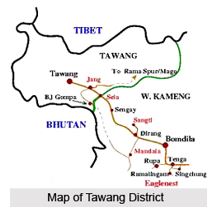

13th December 2022 (5 Topics)
Context
Recently, the Indian and Chinese soldiers were engaged in a face-off along the Line of Actual Control (LAC) in the Tawang sector of Arunachal Pradesh, which again ignited the clashes between India and China over the disputed region in the Arunachal border.
About
About the issue:
- Location: Tawang Sector in India’s northeastern territory of Arunachal Pradesh, a remote, inhospitable region that borders southern China.
- Outcome: Soldiers from both sides sustained minor injuries in the face-off.
- In certain areas along the LAC in the Tawang sector, there are areas of differing perception, wherein both sides patrol the area up to their claim lines. This has been the trend since 2006.
- The clash occurred as a large PLA patrol came across the Indian side in the region.
|
China recently complained about India’s growing closeness with the United States, including in the realm of military cooperation. This month, the U.S. Army’s 11th Airborne Division held exercises with their Indian counterparts in exercises known as Yudh Abhyas. |
Marking the India-China border:
- The border between India and China is not clearly demarcated throughout.
- Along certain stretches of its 3,488 km length, there is no mutually agreed Line of Actual Control (LAC).
- India, following Independence, believed it had inherited firm boundaries from the British, but this was contrary to China’s view.
- China felt the British had left behind a disputed legacy on the boundary between the two newly formed republics.
- The India-China border is divided into three sectors;
- Western: The boundary dispute in the Western Sector pertains to the Johnson Line proposed by the British in the 1860s that extended up to the Kunlun Mountains and put Aksai Chin in the then princely state of Jammu and Kashmir.
- Middle: In the Middle Sector, the dispute is a minor one. It is the only one where India and China have exchanged maps on which they broadly agree.
- Eastern: The disputed boundary in the Eastern Sector of the India-China border is over the McMahon Line.
The reason behind such face-offs:
- Overlapping claims: Face-off and stand-off situations occur along the LAC in areas where India and China have overlapping claim lines.
- Differing perception: The LAC has never been demarcated. Differing perceptions are particularly acute in around two dozen spots across the Western (Ladakh), Middle (Himachal Pradesh and Uttarakhand), Sikkim, and Eastern (Arunachal Pradesh) sectors of the India-China border.
|
The Tawang region:
A recent development by India in the region: |
How the two countries are working towards strengthening security?
|
India |
China |
|
|





